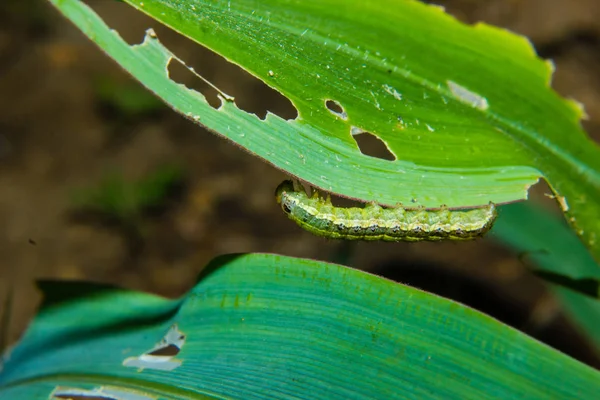
Orugas o gusanos
WHAT IS AND HOW TO ELIMINATE
Fall Armyworm
Spodoptera Frugiperda
Pathogen:
Insect
Type:
Risk to the plant:
CRITICAL



DESCRIPTION
WHO CAUSES IT?
Spodoptera frugiperda, commonly known as the corn fall armyworm, is a lepidopteran of the Noctuidae family that causes significant damage to various crops, especially corn. Their life cycle begins with the laying of eggs on the undersurface of leaves, usually in masses of 100 to 200 eggs, which hatch in about 3 to 5 days. The larvae go through six larval stages, during which they feed voraciously on the leaves, buds and ears of corn. This larval period lasts between 14 and 30 days, depending on environmental conditions, especially temperature. At the end of the larval stage, the larvae descend to the ground to pupate, where they burrow and form a chrysalis. The pupal stage lasts 8 to 30 days, after which the adult, a grayish-brown moth, emerges. Adults are nocturnal and live approximately 10 to 21 days, during which they reproduce and restart the cycle by laying new eggs.
SYMPTOMS
The corn fall armyworm causes a disease that severely weakens corn plants, reducing the yield and quality of the crop. Symptoms of this disease include visible damage to various parts of the plant.
- Perforated and torn sheets.
- Presence of excrement on the bud and leaves.
- Extensive damage to buds and tender shoots.
- Perforations in the ears and grains.
- Malformation of ears.
- Yellowing and necrosis of the leaves.
- Reduction in the general development of the plant.



TEMPERATURE AND HUMIDITY
20°C - 30°C
70% - 90%

HOW IS IT SPREAD?
Flying adults, wind, movement of infected plants, agricultural machinery, contaminated seeds

HOW TO REMOVE IT?
Home remedies
There are no home treatments
Chemical treatments
• CYPERMETHRIN 5% [EC] P/V
• CYPERMETHRIN 0.8% [MG] P/P
• DELTAMETHRIN 1.5% [EW] P/V
• DELTAMETHRIN 1.57% [SC] P/V
• DELTAMETHRIN 10% [EC] P/V
• DELTAMETHRIN 2.5% [EC] P/V
• DELTAMETHRIN 2.5% [EW] P/V
• LAMBDA CYHALOTHRIN 0.15% [GR] P/P
• LAMBDA CYHALOTHRIN 0.24% [GR] P/P
• LAMBDA CYHALOTHRIN 0.4% [GR] P/P
• LAMBDA CYHALOTHRIN 10% [CS] P/V
• TEFLUTRIN 0.5% [GR] P/P
Authorized treatments in organic farming
• LAMBDA CYHALOTHRIN 0.15% [GR] P/P
• LAMBDA CYHALOTHRIN 0.24% [GR] P/P
• LAMBDA CYHALOTHRIN 0.4% [GR] P/P
• LAMBDA CYHALOTHRIN 10% [CS] P/V
Insect allies
EFFECTIVE PRODUCTS TO ELIMINATE THIS PEST
Sponsored link
Sponsored link
Sponsored link
Sponsored link
Sponsored link
Sponsored link
Effective against all types of fungi
- Carry out constant monitoring of the crop to detect the presence of larvae early.
- Use pheromone traps to capture and monitor adult moth populations.
- Implement crop rotation to interrupt the life cycle of the fall armyworm.
- Apply biological insecticides such as Bacillus thuringiensis (Bt) at critical moments of larval development.
- Promote the use of resistant or transgenic corn varieties that contain Bt genes.
- Maintain biodiversity in the fields to favor the presence of natural enemies of the fall armyworm, such as parasitoids and predators.
- Avoid excessive use of chemical insecticides that can eliminate natural enemies.
- Practice integrated pest management that combines biological, cultural and chemical methods.
- Perform appropriate agronomic practices, such as crop residue removal and tillage, to reduce pupal populations in the soil.
- Educate farmers on best pest management practices and the importance of continuous surveillance.




















